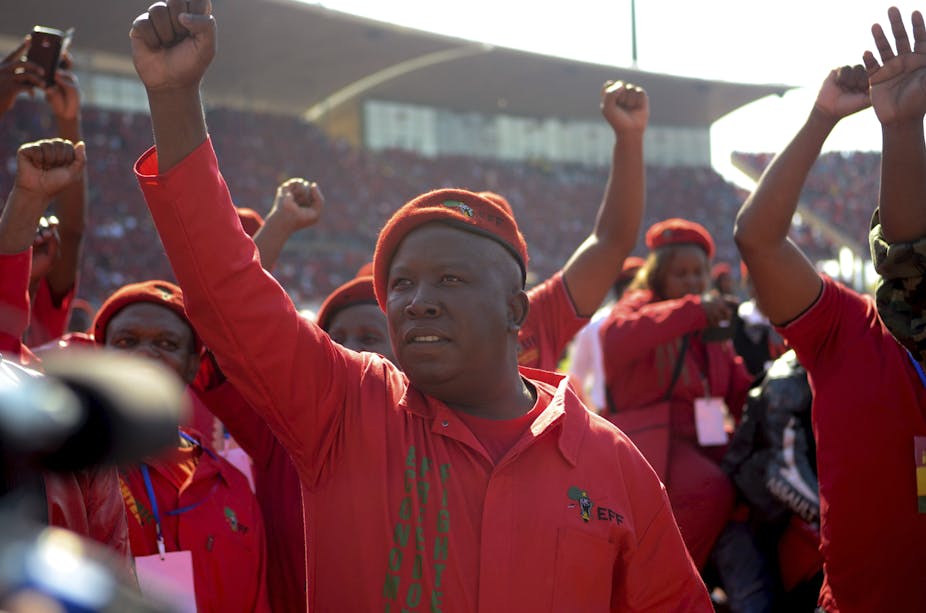Addressing the Oxford Union recently, Julius Malema, leader of South Africa’s opposition party the Economic Freedom Fighters, did something few South Africans have dared: he challenged Nelson Mandela’s post-apartheid legacy.
Malema accused Mandela of “turning against himself” in abandoning elements of the Freedom Charter during the democratic transition in the early 1990s. The charter was drawn up by a coalition led by the African National Congress (ANC) in the 1950s and is still viewed as the blueprint for an equal, non-racial and democratic society. Mandela, he noted, was hosted by a rich white man after his release, and attended
the club meetings of those white men who owned the South African economy.
Malema touched a nerve. The ANC’s promised economic transformation has been disappointing in several ways. Poverty hasn’t reduced quickly enough, inequality remains at world-beating levels, and the pace of growth has, on average, been pedestrian. It is currently glacial.
It is quite likely that decisions made during the transition, before and after 1994, contributed to this outcome.
Poor performance compared with peers
In a recent paper, colleagues and I showed that growth in South Africa since 1990 has been very slow compared with other middle income developing countries such as Malaysia, Turkey and Brazil. In per capita terms, South Africa is clearly the poorest performer.
The country has performed poorly on other measures too.
Exports over this period have been the weakest,
investment levels have been the lowest,
domestic levels of competition are very weak, and
performance on innovation indices is steadily declining.
More importantly, poverty remains persistently and unconscionably high at over 40%. This is despite the fact that the reduction of poverty accelerated in the 2000s with faster growth and the extension of social grants.
And inequality remains extremely high in an era when even countries in the notoriously unequal region of Latin America have shown that inequality can be reduced.
Compared with similar middle income countries, the gap between the richest 20% and the rest is considerably greater in South Africa.
Of the 50 richest Africans in the Forbes Africa’s 50 richest list, 16 are South Africans, and only two of the South Africans are black. Three of the four richest Africans are white South Africans.
Economic transformation is slow indeed.
The 1994 compromises
It is certainly possible to trace some of the country’s relatively poor performance since 1994 to compromises of that era. Established business mounted a concerted campaign to maintain the existing structures of the economy. This was a key item on the agenda of a series of meetings with ANC and other opposition leaders in the 1980s and early 1990s. This demonstrated short-termist defensiveness and a lack of imagination about South Africa’s future.
It is important to remember that the era was characterised by the poor economic performance of most other African countries. And Latin America was absorbed in a seemingly unending series of debt crises. In this context, reassuring investors on whom the country was believed to depend was a high priority for the ANC and the new government.
Attempts to build a mechanism to drive economic transformation failed as the level of trust between business, labour and government deteriorated through the late 1990s and early 2000s.
Had the ANC not been constantly looking over its shoulder, what might have been different? Some examples:
assets such as wealth and land could have been more radically redistributed;
the Reserve Bank could have been given a full-employment mandate (like the Fed in the US);
competition policy could have attacked oligopolistic structures, not only anti-competitive behaviour;
a more vigorous industrial policy might have been introduced;
small businesses could have had more committed support; and
the apartheid structure of cities could have been more urgently addressed.
Such interventions were constrained by concerns for economic stability.
There were poor policies too
South Africa’s capacity to transform the economy was also undermined by accidents of poor thinking, or the by-products of political horse trading. Examples of these include:
the excessively radical liberalisation of agricultural markets and structures;
some very poorly conceived reforms in basic education in the first two post-1994 governments;
the very poor design of privatisation of some state owned enterprises; and
the constrained and complex designs for the liberalisation of some key network industries, especially in the ICT and energy sectors.
What could be done
An interesting thought experiment would be to separate the missed opportunities and policy accidents into two categories.
The first category would be those that could have been avoided. The second those that were really difficult to avoid in the political climate of a peaceful transition through negotiation.
This separation would not necessarily indicate which of the mistakes is reversible today. But reviewing compromises and mistakes made during the transition would be a very fruitful exercise if accompanied by strategic thinking about what to do about these policies today.
Strategic thinking means thinking about what political bargains are possible, and how to build an environment of trust that would encourage short-term sacrifices for long-term gain.

